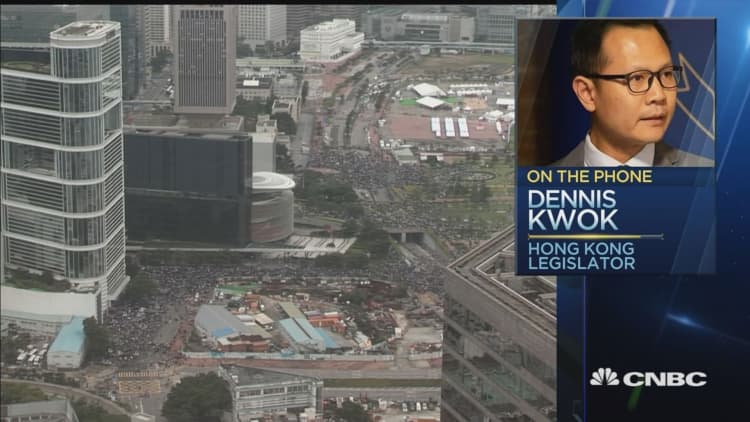Tensions remained high in Hong Kong on Wednesday with tens of thousands of protesters gathered around the local legislature and lawmakers postponing debate on the proposed legal changes that incited the demonstrations.
More than 200,000 protesters — and potentially just in excess of 1 million — took to the city's streets on Sunday to oppose a local government proposal allowing fugitives to be handed over to authorities in mainland China. By most counts, the ongoing demonstration is one of the biggest since the British handed over the territory to China in 1997.
The Chinese government has called the pushback on the introduction of the bill an internal affair of Hong Kong, but is also on record as supporting the changes.
"(The changes) will only improve instead of undermining the rule of law in (Hong Kong), and better safeguard the rights and freedoms that Hong Kong residents enjoy in accordance with law," the foreign ministry's local office said on its website on May 31.
On the surface, the people of Hong Kong are fighting over the amendment of a set of extradition laws, but some say the demonstration has become part of the movement for the bigger-picture fight for autonomy.

When it took over from the British, China promised that Hong Kong would retain certain liberties, such as freedom of speech and an independent judiciary, through 2047. That's led to a political situation often described as "one country, two systems."
Since the merger of Hong Kong and the mainland began, however, the two systems have often appeared to be at odds. So while many signs and chants at the ongoing protest are focused on opposing the extradition proposal, they're fundamentally underpinned by that long-simmering conflict.
Opposition leaders acknowledge that the protest highlights concerns about the legal independence of Hong Kong, and the weakening of local law. The independence of the judiciary is not only a political sentiment valued by the people of Hong Kong but also often an incentive for international companies using the city as a commercial base of operations.
To understand the extent to which the ongoing protests are about more than just extradition, it's important to see how they connect to Hong Kong's recent history of large-scale demonstrations.
A history of protest
The Hong Kong government says the legal changes are necessary, citing a case last year when a Hong Kong man allegedly killed his girlfriend while in Taiwan before subsequently returning home. The government says he can't currently be extradited to Taiwan because the two territories do not share an agreement, though legal critics reject that interpretation and say there are various ad hoc measures that could be taken.
This demonstration comes at a sensitive time, only a few days after the 30th anniversary of the Tiananmen Square massacre on June 4 and just two weeks before the 22nd anniversary of the handover.
The city has a long history of protests marking the date of the handover: On July 1 in recent years, some Hong Kongers have assembled to make their political opinions — including calls for universal suffrage — known. That practice attracted international attention in 2003 when it drew 500,000 marchers to the streets.
The protest was focused on opposing a proposed national security bill aimed to amend the laws dealing with treason, sedition, subversion and other acts. The attempt to implement the article caused great controversy and worries regarding Beijing's control of civil rights in Hong Kong.
Umbrella Movement
Hong Kong protests last made international news in 2014, during what has been deemed the Umbrella Movement.
That year, the Chinese government released a white paper proclaiming that Hong Kong doesn't enjoy full autonomy from Beijing. That was perceived as a sign the Chinese government was suggesting it could intervene in Hong Kong affairs, redefining "one country, two systems."
The protests began after the Chinese government proposed reforms to the Hong Kong electoral system, subjecting candidates for Hong Kong's leadership post to be pre-screened by the Chinese Communist Party.
The demonstration earned its internally known name due to the significant number of protesters using umbrellas to defend themselves from the pepper spray used by the police. The rally was an act to demand universal suffrage, in particular.
But the crowds dissipated without achieving any concessions from the local government or Beijing.
In fact, in April of this year, nine democracy activists were convicted by a Hong Kong court on public nuisance charges for their participation in leading the protests five years ago. The movement has galvanized protesters' continued demand for democracy, autonomy and universal suffrage.
— Kelly Olsen and Reuters contributed to this report.


